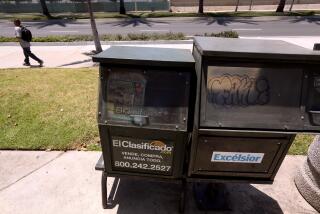War of Words--Chinese Style : Papers Fight for Readers Amid Rising Competition, Waning Ad Income
- Share via
THE REGION — There is a newspaper war raging the streets and storefronts of this region’s Chinese neighborhoods, a crowded fight to secure a market share in one of the fastest-growing immigrant communities in the San Gabriel Valley.
Five daily Chinese-language newspapers and nearly a dozen weeklies are battling for readers and crucial advertising revenues. Publishers say the competition is so severe that most of these San Gabriel Valley-based publications are struggling just to stay in business.
Indeed, if 1990 census figures and the daily papers’ circulation figures are accurate, there are twice as many such newspapers printed each day as there are Chinese households in Los Angeles County. And that does not include the multitude of weeklies.
“When I first came here in 1980, there was nothing but the Chinese version of the TV Guide,” said Paul Yin, treasurer of the weekly Press Freedom Guardian. “Now there are stacks of six or seven newspapers in front of every supermarket.”
Most of the newspapers are free; they are supported by advertising from local Chinese businesses. Some larger companies, such as A T& T and Pacific Bell, are also beginning to advertise in the newspapers.
The recession has only fueled the competition. As local Chinese businesses trim their advertising budgets or eliminate them, the newspapers are fighting for a shrinking pool of advertising money.
“The competition is quite fierce. Except for the big dailies, most of these papers are losing money. They’re just trying to survive,” said Charles Hou, publisher of the weekly American Chinese Business Journal.
Hou admitted that his paper is suffering losses, but many other publishers refused to discuss the financial health of their newspapers because they feared it would give their competitors an edge.
Even at the Chinese Daily News, widely recognized as the largest and most stable of the Chinese-language publications, officials make it a policy not to disclose their circulation figures--even to staff members and advertisers.
General Manager Sharon Wang said the company would rather keep those numbers a secret than participate in an inevitable game of circulation inflation with the other newspapers.
“We’re confident that we are the dominant leader by a large margin. Those other newspapers compete with each other, not with us,” she said.
Wang acknowledged that the recession has slowed her paper’s growth, and that it loses advertising accounts to competitors with lower rates. But she said the paper won’t cut ad rates because it has the readership with the most purchasing power.
The newspaper, a subsidiary of Taiwan’s United Daily News, costs 35 cents and contains four sections with more pages than any of the competitors. It operates with a staff of about 170, including 16 local news reporters.
Chinese Daily News officials are so sure of their position at the top of the heap that they recently built a spacious new headquarters on 2.7 acres in Monterey Park. Only three of the four floors are occupied but officials plan to continue expanding.
If the Chinese Daily News is the largest Chinese-language newspaper in the area, four other dailies vie for the No. 2 spot: the Chinese-American Daily News, the Chinese Free Daily News, the International Daily News, and the Sing Tao Daily.
The newspapers vary in quality and scope, but all of them are scrambling to secure a niche of readers or advertisers. The Sing Tao Daily, for example, focuses its coverage on Hong Kong and immigrants from that region.
The Chinese-American Daily News, on the other hand, tries to attract advertisers with rates that are half those of the Chinese Daily News. Editorial content is less of a priority at the paper, said Catherine Shih, co-publisher.
The fastest-growing of the bunch may be the Chinese Free Daily News, which joined the fray in 1991. Publisher Walter Chang said the newspaper is making a profit and has a circulation of 35,000.
Chang said the newspaper is popular because it is free and because it focuses almost entirely on news from Taiwan, with only a few pages devoted to local news.
He said it is making money because its costs are limited. The bulk of its editorial content is purchased and flown in from a newspaper in Taiwan, the Liberty Times. The news is two days late, but it is also cheap.
In addition, the Chinese Free Daily News is owned by L.A. Webb Offset Printing. The El Monte company prints several other publications and thus saves on printing costs.
The success of the Chinese Free Daily News has hurt the older International Daily News, the only paper with a staff that produces all of its own editorial content.
Simon Chen, the publisher, said that revenue is down about 20% but that the 12-year-old newspaper is still breaking even.
The International Daily News fared better during the 1980s, when it was considered the most objective and outspoken of the Chinese-language newspapers.
During that decade, Chinese-language newspapers served more as political instruments and were often associated with either China’s Communist Party or Taiwan’s ruling Kuomintang Party.
Since the Taiwan government lifted martial law in 1987, though, the papers have become more objective, and thus more alike and more competitive.
In addition to the five dailies, there are a variety of weekly newspapers that specialize on everything from the Hong Kong entertainment scene to religion to Taiwanese politics.
There is at least one weekly that caters to Chinese-speaking immigrants from Vietnam and other parts of Southeast Asia, the Vietnam-Chinese Newspaper, and at least one successful weekly serving the new wave of immigrants from mainland China, the China Journal.
H.T. Wei, publisher of the 28,000-circulation weekly United Times, said many weekly Chinese-language papers are short-lived because they start printing without a market plan.
“When a new paper comes out, they come out strong and the ad market shakes a little bit. After a few months, it dies and everything goes back to normal. Then a few months later, someone else will start another one,” said Wei, who counts among his competitors a weekly started by his ex-wife.
The list of daily Chinese-language newspapers that have gone out of business in recent years is also long: the China Times, the Centre Daily News, the California Daily, the Far East Journal and the Young China Daily.
Although the region’s Chinese population is growing and makes up nearly 8% of the San Gabriel Valley’s 1.7-million population, newspaper officials conceded that it is not growing fast enough to support the number of publications.
“We’re not going to close down, not while I’m around,” said Chen of the International Daily News. “The most that the community can support is three dailies, so we’ll see who goes first.”
Chinese Newspapers
All but Chinese-American Daily News are local editions of national or international newspapers.
Chinese Daily News
* Location: Monterey Park
* Circulation: Not available
* Price: 35 cents
* Founded: 1981
Chinese Free Daily News
* Location: El Monte
* Circulation: 35,000
* Price: Free
* Founded: 1991
Sing Tao Daily
* Location: San Gabriel
* Circulation: 25,000
* Price: 35 cents
* Founded: 1989
International Daily News
* Location: Monterey Park
* Circulation: 21,000
* Price: 35 cents
* Founded: 1981
Chinese-American Daily News
* Location: Monterey Park
* Circulation: 20,000
* Price: Free
* Founded: 1990
More to Read
Inside the business of entertainment
The Wide Shot brings you news, analysis and insights on everything from streaming wars to production — and what it all means for the future.
You may occasionally receive promotional content from the Los Angeles Times.










